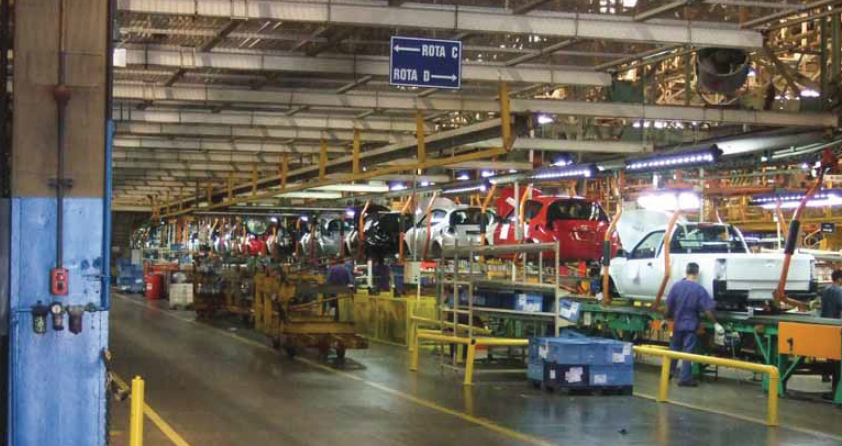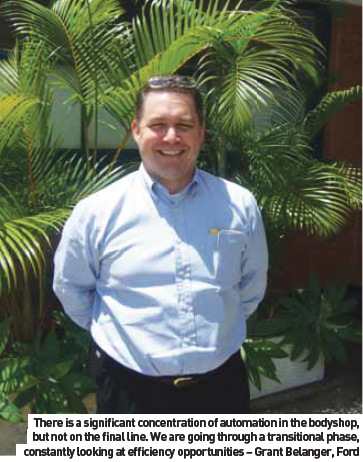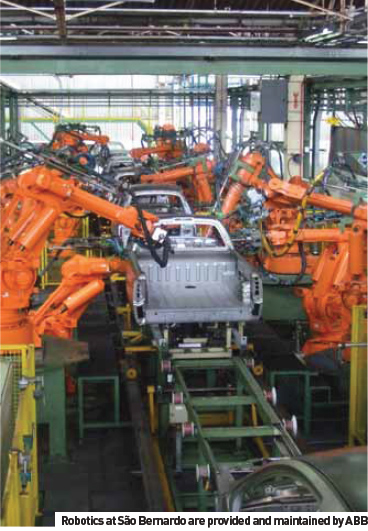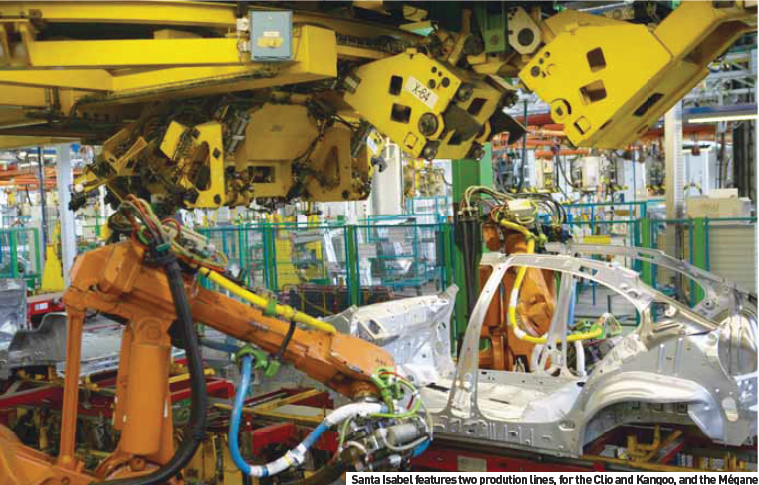
New credit laws have led to a boom in demand for new cars in Brazil, while Argentina is still on the rebound from the 2001 financial crisis. What does this mean for manufacturing in the region?
As the US and European economies struggle to come to terms with loose lending and tightening credit markets, other regional economies around the globe carry on their day-to-day business relatively unaffected by the turmoil. South American carmakers, in particular, are enjoying great success, with burgeoning economies creating an expanding middle class eager to purchase any and all of the products they can produce.
Nowhere is this more true than in South America, where talk of a credit crisis is virtually non-existent. In fact, in the case of Brazil, the continent’s largest car-producing nation, the relaxing of what Western observers would have perceived as nothing less than draconian consumer credit terms have created a mini-boom in sales of virtually all domestic consumables, including cars.
National boom
According to figures supplied by Brazil’s National Association of Vehicle Manufacturers (Associação Nacional dos Fabricantes de Vehículos Automotores or ANFAVEA), 2.97 million units were produced nationally in 2007, an increase of 13.9 per cent over the 2.61 million units produced in 2006. Sales figures are even more impressive, with 2.46 million units being registered in 2007, a massive increase of 27.8 per cent over the 1.93 million of the preceding year.
Grant Belanger, Director of Operations and Quality at Ford Brazil, confirms the numbers. “The industry has exploded, 2006 and 2007 were very good years. Even while imports are a very small part of the market, their sales numbers are forecast to be up 44 per cent in 2008 from 2007 numbers.” In terms of the availability of credit to Brazilian consumers, Belanger explains: “Both the US and Europe have very sophisticated credit markets, whereas credit in Brazil has not been allowed to develop due to currency constraints. Only recently has there been a relaxation in the local credit market and this has led to an explosion in the market. Affordability is a major factor, but now typical Brazilians can consider purchases they could not previously.”
It is this new purchasing power that is supporting the boom in the auto market, prompting Ford and other companies to increase investment in the region.
 Asset management
Asset management
Ford’s Camaçari plant, located in Bahia, north-east Brazil, opened only seven years ago and is currently running three shifts, six days per week to produce the Fiesta hatchback and sedan, and the Ecosport, a two- or four-wheel drive mini-SUV based on the Fiesta platform, of which a facelifted version was introduced in October 2007. Meanwhile, at the company’s São Bernardo facility, improving efficiency has been the name of the game. São Bernardo is the largest of the company’s seven Brazilian plants and home to two separate assembly facilities (a unibody line for the Ka and Courier, and a line for the F-Series truck, Super Duty F, F250 and Cargo). But, as Belanger explains, some streamlining has been necessary: “Between 1999 and 2000 we were forced to lay off a full second shift. Since then, there has been a significant restructuring of the São Bernardo plant, with full cooperation from our unions. In fact, one of the hallmarks of working in South America is how very business-case orientated we’ve become when deciding how much asset we put in. We have a very cost-conscious culture because, in the past, our fixed costs got out of hand. Now we make sure that we have very productive assets in place and that those assets can be supported.
“The unrelenting requirement to obtain efficiencies in manufacturing, while reducing costs and improving competitive quality, is no different in Brazil than it is anywhere else in the world. Perhaps more so, we need to get the product to market for as low a price as possible,” he says.
Revising the supply
The December 2007 launch of the new, locally-designed Ka (referred to internally as the B402), is a case in point. From the outset, keeping costs down was paramount. As Belanger points out: “There was not a significant tear-up of the final assembly area for the new Ka. It was very efficient, reusing a lot of existing parts across the South American product line.”
Yet Ford was still looking to double the capacity of the production line to accommodate anticipated demand for the new model. “With the introduction of the Ka we re-engineered material flows, with a lot of knitting and sequencing changes. Also, we improved speed and sequence delivery to lineside, with the system set to trigger broadcasts as materials are needed, based on the chassis that is coming through.” Whereas the Camaçari plant is a largely self-contained facility, with additional automation in the body and paint shops, São Bernardo sends out stamped and painted door panels for full assembly by a third-party company, only receiving the finished doors lineside in a just-in-time arrangement.
A complete review of lineside supply was required with the introduction of the new Ka model. “We went from 28 to 52 jobs per hour. This changed all our takt times, requiring us to completely rebalance the line. The Courier continues to run through the same line, but now the ratio of Kas to Couriers has dramatically increased,” he adds.

Rebalancing the line
As in most car plants, automation on the production line has its role to play, but any changes are carefully analysed before being implemented. “As you would expect, there is a significant concentration of automation in the bodyshop, but not on the final line. We are going through a transitional phase, constantly looking at efficiency opportunities, making a business case in terms of safety, quality, cost and potential incremental output.”
An extra 100 employees were required to support the newly-rebalanced line, the first hiring at the plant in 12 years. With regard to whether additional automation would benefit the plant, Belanger offers a pragmatic viewpoint. “We look at automation in terms of product role, sometimes driven by design, sometimes by efficiency and economic targets, but when you look at it in dollar terms, with a 30 per cent increase in the value of the local currency, you have to compare direct and indirect influences, examine the labour balance on a day-to-day basis to achieve our required efficiencies.” That said, Belanger sees potential for an expanded use of automation across the local industry. “Look at what has happened in a short period of time. In terms of developing the industry, automation is becoming more affordable due to the currency valuation.”
Robot sourcing
Talking of automation, Ford’s robots are sourced through a combination of foreign hardware with local support. “Most of our robots are imported. There is some local activity in the region, by ABB for example, but most core assets are in Asia. We do source from local automation providers where possible, but most come from overseas.” Silvio Illi, Plant Manager at São Bernardo, offers further insight. “Our robots were supplied and installed by ABB. It also supplied the software and maintains them. The current plant dates from 1962 but this equipment is from 1995. We may have some equipment that is slightly older, not stateof- the-art, but the concept of production is exactly the same as elsewhere in the world.”
Illi explains that there is a series of seven quality control checkpoints throughout the production process, checking among other things the closures, underbody and completed body. “We take one (bodyside) per hour to check the weld quality. We put a perfect bodyside weld pattern in the computer memory and lasers compare the example to that template. There are about 1,000 welds on each bodyside and each has to pass within a tolerance of 1.5 millimetres. We account for each bodyside to check those made before the inspection; if there is a problem an engineer will make the correction on the assembly line.”
 In addition to the production line spot checks, between eight and 14 cars a day are subjected to a post-production audit. This comprises a test of each vehicle’s electricals, chassis and powertrain, 13 systems in all. Says Illi: “The tests take up to four hours per car. Any problems that are found are traced back through the cars produced at the same time and fixed.” One hundred per cent of production goes through a road test, running the vehicle over a dedicated test track that features a series of different surfaces. “This is not a technical assessment of the noise of the vehicle. The testers don’t carry any equipment. Instead, they put themselves in the place of one of our customers, using their training and experience to check for any significant issues that we can fix before shipping.”
In addition to the production line spot checks, between eight and 14 cars a day are subjected to a post-production audit. This comprises a test of each vehicle’s electricals, chassis and powertrain, 13 systems in all. Says Illi: “The tests take up to four hours per car. Any problems that are found are traced back through the cars produced at the same time and fixed.” One hundred per cent of production goes through a road test, running the vehicle over a dedicated test track that features a series of different surfaces. “This is not a technical assessment of the noise of the vehicle. The testers don’t carry any equipment. Instead, they put themselves in the place of one of our customers, using their training and experience to check for any significant issues that we can fix before shipping.”
Bigger flex and alcohol
Engines for the Ka and Courier production line are shipped unfinished from the Ford plant in Taubate, located in the interior of São Paulo state. “Here we dress the engine, install the electronics, starter motor, alternator, fuel injection systems. Almost 85 per cent are flex, and if it’s not flex, it’s for export to Argentina,” says Illi.
Since their market introduction in 2001, ‘flex’-powered vehicles have come to dominate Brazil’s locally-produced new car market. In fact, numbers released by ANFAVEA show that in 2007, flex-powered cars accounted for 85 per cent of new vehicle purchases in Brazil, up from only four per cent of the market as recently as 2003. ‘Flex’ refers to engines capable of running on petrol and what is referred to locally as alcohol (ethanol, derived from sugar cane), or any given mix of both fuels. Originally introduced in the 1970s, alcohol-only vehicles enjoyed a period of success until a fall in oil prices and a rise in the price of sugar cane made refining the fuel uneconomical. Fast-forward to today’s rocketing oil prices and the fuel, generally priced a third cheaper than petrol, has made a monumental comeback, supported largely by the introduction of the flex engine.
A uniquely Brazilian phenomenon, alcohol as a fuel is virtually unheard of anywhere else in South America. That is not to say that alternative fuels are ignored. In Argentina, Renault is the only OEM to install liquid petroleum gas (LPG) systems as new equipment in the ‘Family’ versions of their Kangoo, Clio and Megane ranges.
Juan Marcelo De Carlo, Product Communications Manager for Renault SA (Argentina) explains: “Aftermarket LPG systems require the cutting of holes in the subframe, which compromises the galvanized metal. With our (bespoke) system, the necessary fixing holes are made before the body is galvanized, ensuring that the bodywork is fully protected.” The system also had to meet rigorous specifications as set down by Renault headquarters. “Aftermarket systems usually position the LPG fuel tank under the car to save interior space. For safety and security reasons, Renault in France mandated that the tank be positioned within the car’s frame. We developed a special support for the tank, plus special lifting gear had to be developed for the production line to assist with fitting the tank.”
Petrol preference
Overall, the Argentinian car market is on the rebound from the financial crisis that hit the country in 2001. Supported by heavily-subsidised fuel prices, negotiated between local fuel producers and the national government to assist the recovering economy and to control inflation, car sales have begun to increase. Yet, with the two fuels being virtually the same price, there has been a swing towards purchasing petrol-fuelled vehicles.
According to De Carlo, locally-produced diesel-powered vehicles have little chance of taking advantage of the latest technologies, due largely to the new particulate filtration systems. “Renault Europe is developing Euro 4 engines, fitted with a FAP filter that traps particulates. Our diesel fuel is not refined enough to allow the use of this engine. Our locally-produced diesel fuel produces 1,000 particulates, compared to two particulates for the same amount of European-grade fuel. The filter would get clogged in 10,000km and aside from the inconvenience, it’s not cheap to replace.”
 And an improvement in the refining process is not likely for the foreseeable future. “With Brazil making it illegal to sell diesel passenger cars, the volume of diesel cars sold does not warrant any improvements to the fuel-refining process. Cars would have to be sold in both countries to improve the economies of scale. It’s just not cost-effective to build refineries making cleaner diesel.”
And an improvement in the refining process is not likely for the foreseeable future. “With Brazil making it illegal to sell diesel passenger cars, the volume of diesel cars sold does not warrant any improvements to the fuel-refining process. Cars would have to be sold in both countries to improve the economies of scale. It’s just not cost-effective to build refineries making cleaner diesel.”
Location, location, location
In terms of auto production, sales and import, Argentina is a victim of its own geographic location. As De Carlo points out, shipping costs and taxes make the final price of any imported model, other than luxury vehicles, prohibitively expensive.
“Argentina has locally-produced SUVs, but not premium SUVs. These have to be imported. But importing small cars makes no sense as once you add the 35 per cent tax on vehicles sourced outside Mercosur (Mercosul, the Mercado Commum do Sul, or Southern Common Market, comprising Brazil, Argentina, Paraguay and Uruguay as full partners), 21 per cent local VAT and the US$800 shipping costs (per unit), they would not be able to compete on price with similar, locally-produced models.
“Within Mercosur, we pay zero tax on imports, but only if there is an exchange. Meaning that if you only build cars in Brazil and import them into Argentina, you will pay an import tax. If you build cars in both Brazil and Argentina, the exchange of cars generates zero tax. For example, until Honda finishes its new plant, it must pay tax on all Civic and Fit models imported from Brazil.
“In the case of Mexico, we have a country-to-country agreement for zero tax. The only problem with this is that Mexico builds to US car regulations. This means models have lights, glazing and other components that do not meet our (European standard) specification and we must wait until they homologate before importing.”
Personal space issues
Local car buyers also have different priorities in terms of what they look for when buying a new car. “Apart from price, which is of course a key element in the buying decision, local customers do not have the same values as buyers elsewhere. Here, customers buy on space with less equipment. Where European buyers will trade up a model to gain interior space, our customers look for greater space in smaller vehicles.”
Case in point, De Carlo describes the locally-produced, short wheelbase Kangoo, for which Renault in Argentina has developed a third row of seats. “This is a version of the Kangoo II which we developed here and is not available anywhere else. The seven-passenger capacity appeals to the local market.” Before being made available, the version had to pass stringent testing in France. “We took two units to Paris for crash testing, after which we made two new units incorporating the changes outlined by Renault France.” Space is such a priority in the design and manufacture of vehicles for the local market that it can make otherwise popular models redundant. “We used to import a CKD version of the Twingo, which was assembled at a private factory. But that factory has closed and it would not be cost-effective to replace it, so we will not import the Twingo II. Additionally, the Twingo is a highly-specified model, with limited interior space – a combination that does not appeal to local customers.”
Manufacturing – Argentina-style
In 1992, Renault Argentina was sold to a local investment enterprise, CIADEA, which went on to build and distribute cars under private ownership. The only arm of Renault that was not directly under the French group’s umbrella, the enterprise jumped from boom to bust before being bought back by the parent company in 1997. “In 1991, Carlos Menem (the then Argentinian president) linked the peso with the dollar, making Argentina a very expensive place to do business. As such, most of our Tier One partners relocated to Brazil and we either had to import the required parts or manufacture them here. Now most suppliers have returned, allowing us to invest in capacity,” says De Carlo.
“This is an integral part of the Renault Commitment 2009, launched by company President and CEO, Carlos Ghosn in 2006, to increase the percentage of locallysourced parts and spread the cost of car production.” All Renault’s locally-produced models are built at the company’s Santa Isabel plant in Cordoba. “The plant has two production lines, one for the Clio and Kangoo, the other for the Megane. All the processes are here, stamping, painting, assembly.” In fact, the plant even has its own university, the Renault Technical Institute, from which 85 per cent of the plant engineers and all the plant’s executive committee have graduated. Courses are related to carmaking and the Institute offers reduced tuition fees for the children of employees. “Santa Isabel is a very old, very big factory, but also, it is a very modern facility. In April, we started a second shift to service the increase in demand.” Renault Argentina builds 75 per cent of all Renaults sold in Argentina, with the other 25 per cent being imported from Brazil (the Logan and new Sandero), as well as the latest, European-built Megane II, Scenic II and Laguna III models.

“Cold-weather testing for the Laguna III was done in Sweden, but the conditions here in Argentina were considered ideal for testing the new car at altitude and in dusty conditions,” explains De Carlo. Free from the financial constraints of other economic regions, the South American car market appears to be in rude health, the availability of consumer credit allowing the purchase of new vehicles in unprecedented numbers. With the freedom to develop new models and adapt existing ones, the national representatives are able to tailor their model ranges to local tastes, a flexibility that is sure to pay future dividends as these economies continue to grow.



































